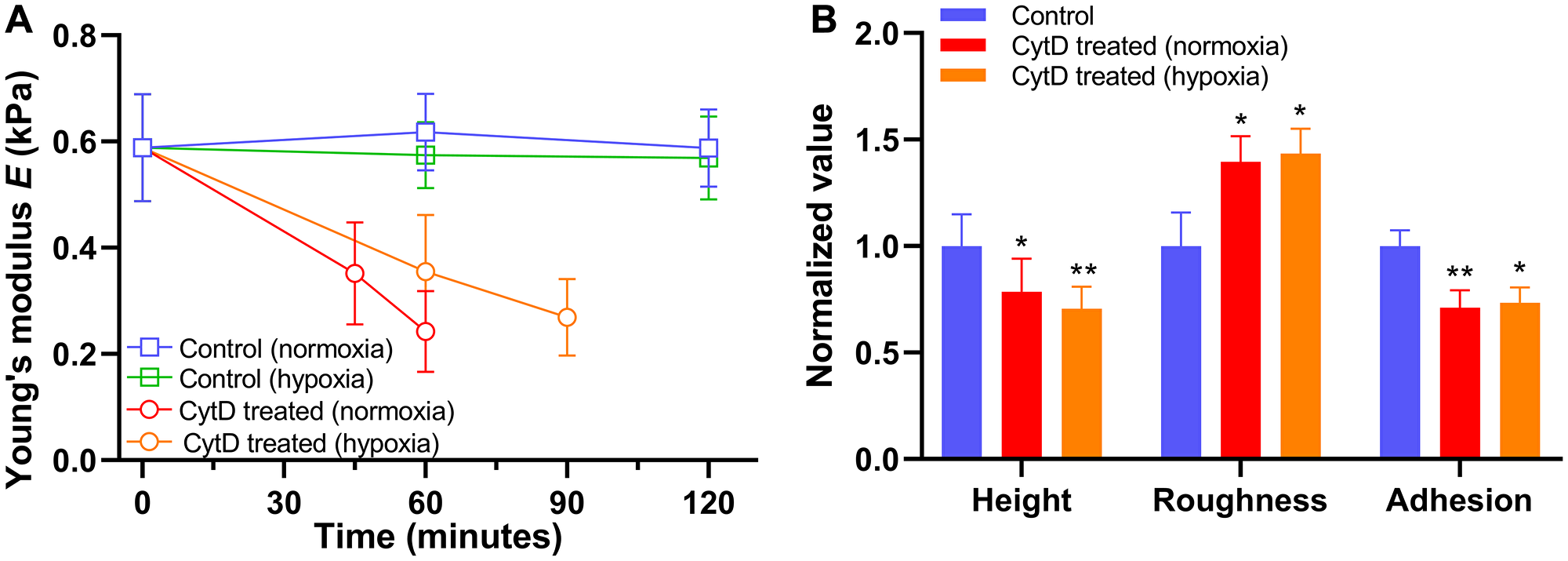Oncotarget published "Dynamic cellular biomechanics in responses to chemotherapeutic drug in hypoxia probed by atomic force spectroscopy" which reported that by exploiting single-cell, force spectroscopy methods, the authors probed biophysical and biomechanical kinetics of brain, breast, prostate, and pancreatic cancer cells with standard chemotherapeutic drugs in normoxia and hypoxia over 12–24 hours.
After exposure to the drugs, they found that brain, breast, and pancreatic cancer cells became approximately 55–75% less stiff, while prostate cancer cells became more stiff, due to either drug-induced disruption or reinforcement of cytoskeletal structure.
However, the rate of the stiffness change decreased up to 2-folds in hypoxia, suggesting a correlation between cellular stiffness and drug resistance of cancer cells in hypoxic tumor microenvironment.
Also, they observed significant changes in the cell body height, surface roughness, and cytoadhesion of cancer cells after exposure to drugs, which followed the trend of stiffness.
These Oncotarget results show that a degree of chemotherapeutic drug effects on biomechanical and biophysical properties of cancer cells is distinguishable in normoxia and hypoxia, which are correlated with alteration of cytoskeletal structure and integrity during drug-induced apoptotic process.
These Oncotarget results show that a degree of chemotherapeutic drug effects on biomechanical and biophysical properties of cancer cells is distinguishable in normoxia and hypoxia`
Dr. Yongki Choi from The North Dakota State University said, "Cell surface plays important roles in fundamental cellular functions such as signaling, communication, adhesion, transport, and tumor metastasis"
The cell surfaces dynamically interact with physical, chemical, and biological environments surrounding cells and thus, alteration in cell's surface structure substantially influences overall cell functions.
In particular, deformability of cells associated with cell shape, motility, and invasion has shown implications for cell death and cancer metastasis, which is critical information for developing new anticancer drugs with increased efficacy in cancer chemotherapy.
While a number of studies have shown the relationship between chemotherapy-induced cell death and alteration in cellular mechanics such as stiffness, the impact of drugs on biomechanical and biophysical properties of cancer cells is not fully understood yet. Furthermore, stiffness at the tissue-level is significantly affected by the tumor stage, invasiveness, and location within the tumor due to the deposition of extracellular matrix, which influences the cellular behavior and metastatic capacity at the single-cell level as well.
Several studies using the AFM-based force measurements also have shown a significant change in cell stiffness with increasing metastatic efficiency in human cancer cell lines and chemotherapy exposure in leukemia cells.

Figure 6: Alteration in biomechanical properties of PANC-1 cells exposed to 5 μM cytochalasin D (CytD) in normoxia and hypoxia. (A) Time trace of Young's modulus E in normoxia (n = 5) and hypoxia (n = 5) after exposure to cytochalasin D. (B) Normalized values of cellular height, roughness, and adhesion measured after exposure to cytochalasin D in normoxia for 60 minutes (n = 5) and hypoxia for 90 minutes (n = 5). Data are mean ± s.d., Repeated measured one-way ANOVA, post-hoc Tukey test; ns, not significant; *P < 0.05; **P < 0.01; ****P < 0.0001. Statistics between normoxia and hypoxia showed no statistical difference (ns).
In this work, these researchers quantified the drug effects on the biomechanical and biophysical properties of four cancer cell lines: MDA-MB-231 triple negative breast cancer, PANC-1 pancreatic cancer, PC-3 prostate cancer, and U-118 MG glioblastoma cell lines.
The Choi Research Team concluded in their Oncotarget Research Output that they have examined changes in biomechanical parameters of cancer cells exposed to an inhibitor of actin polymerization cytochalasin D in normoxia and hypoxia.
The PANC-1 cells became less stiff under increasing duration of exposure to cytochalasin D, and the decrease of stiffness was slower in hypoxia than normoxia.
Also, morphology and non-specific binding force measurements of the cells exposed to cytochalasin D showed a reduction in cell height and cellular adhesion, but an increase in cellular roughness.
Similar changes in biomechanical properties of other cancer cell lines treated with chemotherapeutic drugs and cytochalasin D suggest that the drug-induced cytotoxicity is partly due to dynamic changes in the cytoskeletal structure.
Although it is difficult to generalize drug effects on biomechanical and biophysical parameters of cancer cells, a combination of these parameters could help identify and distinguish the drug-induced apoptotic process in normoxia and hypoxia.
DOI - https://doi.org/10.18632/oncotarget.27974
Full text - https://www.oncotarget.com/article/27974/text/
Correspondence to - Yongki Choi - [email protected]
Keywords - cellular stiffness, roughness, adhesion, drug resistance, hypoxia
About Oncotarget
Oncotarget is a bi-weekly, peer-reviewed, open access biomedical journal covering research on all aspects of oncology.
To learn more about Oncotarget, please visit https://www.oncotarget.com or connect with:
SoundCloud - https://soundcloud.com/oncotarget
Facebook - https://www.facebook.com/Oncotarget/
Twitter - https://twitter.com/oncotarget
LinkedIn - https://www.linkedin.com/company/oncotarget
Pinterest - https://www.pinterest.com/oncotarget/
Reddit - https://www.reddit.com/user/Oncotarget/
Oncotarget is published by Impact Journals, LLC please visit https://www.ImpactJournals.com or connect with @ImpactJrnls
Media Contact
[email protected]
18009220957x105




